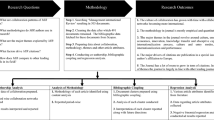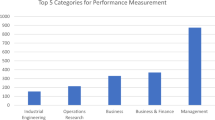Abstract
The aim of this paper is to determine the role that academic collaboration plays on the impact of Latin-American and the Caribbean research on management as an academic research discipline. The results show that the impact of Latin American articles on management, which were published between 1990 and 2010 in JCR journals is positively associated to collaboration r s = .133, p = .001. Collaborated articles have on average 1.22 times more impact than single authored ones. The level of collaboration is positively correlated to impact r s = .337, p = .001. Articles published through international collaboration have 1.59 times more impact than those published through domestic collaboration.

Similar content being viewed by others
References
Abbasi, A., Altmann, J., & Hwang, J. (2010). Evaluating scholars based on their academic collaboration activities: Two indices, the RC-index and the CC-index, for quantifying collaboration activities of researchers and scientific communities. Scientometrics, 83(1), 1–13.
Acedo, F. J., Barroso, C., Casanueva, C., & Galán, J. L. (2006). Co-authorship in management and organizational studies: An empirical and network analysis. Journal of Management Studies, 43(5), 0022–2380.
Acosta, M., Coronado, D., Ferrandiz, E., & León, M. D. (2011). Factors affecting inter-regional academic scientific collaboration within Europe: The role of economic distance. Scientometrics, 87, 63–74.
Adams, J. (2013). The fourth age of research. Nature, 497(May), 557–560.
Adams, J. (2014). Bibliometrics: The citation game. Nature, 510(7506), 470–471. doi:10.1038/510470a.
Adams, J., & Gurney, K. (2013). Leading research economies in a changing knowledge network, Spain. Global research digest. Retrieved May 10, 2013. www.researchanalytics.thomsonreuters.com/grr
Adams, J., & King, K. (2009). Brazil research and collaboration in the new geography of science. Retrieved May 10, 2013.
Avkiran, N. K. (2012). An empirical investigation of the influence of collaboration in Finance on article impact. Scientometrics, 95(3), 911–925. doi:10.1007/s11192-012-0892-5.
Beaver, D., & Rosen, R. (1979). Studies in scientific collaboration: Part I The professional origins of scientific co-authorship. Scientometrics, 52(3), 365–377.
Braun, T., & Glanzël, W. (2001). Publication and cooperation patterns of the authors of neuroscience journals. Scientometrics, 51(3), 499–510.
Bridgstock, M. (1991). The quality of single and multiple authored papers. An unresolved problem. Scientometrics, 21(1), 37–48. doi:10.1007/BF02019181.
Cardoza, G., & Fornés, G. (2011). International co-operation of Ibero-American countries in business administration and economics research. Presence in high-impact journals. European Business Review, 23(1), 7–22.
Carley, S., Porter, A. L., & Youtie, J. (2013). Toward a more precise definition of self-citation. Scientometrics, 94, 777–780. doi:10.1007/s11192-012-0745-2.
Cetto, A. M., & Alonso-Gamboa, O. (1998). Scientific periodicals in Latin America and the Caribbean: A global perspective. Interciencia, 23(2), 84–93.
Cimenler, O., Reeves, K. A., & Skvoretz, J. (2014). A regression analysis of researchers’ social network metrics on their citation performance in a college of engineering. Journal of Informetrics, 8(3), 667–682. doi:10.1016/j.joi.2014.06.004.
Cohen, J. (1988). Statistical power and analysis for the behavioral sciecnes (2nd ed.). New Jersey: Lawrence Erlbaum.
Collazo-Reyes, F., Luna-Morales, M. E., Rusell, J. M., & Pérez-Angón, M. A. (2008). Publication and citation patterns of Latin American and Caribbean journals in the SCI and SSCI from 1995 to 2004. Scientometrics, 75(1), 145–161. doi:10.1007/s11192-007-1841-6.
de Bellis, N. (2009). Bibometrics and citation analysis: From the science citation index to cibermetrics. Toronto: The Scarecrow Press Inc.
Egghe, L. (2006). Theory and practise of the g-index. Scientometrics, 69(1), 131–152. doi:10.1007/s11192-006-0144-7.
Egghe, L. (2012). Remarks on the paper by A. De Visscher, “what does the g-index really measure?”. Journal of the American Society for Information Science and Technology, 63(10), 2118–2121. doi:10.1002/asi.22651.
Ferrara, E., & Romero, A. E. (2013). Scientific impact evaluation and the effect of self-citations: Mitigating the bias by discounting the h-index. Journal of the American Society for Information Science and Technology, 64(11), 2332–2339. doi:10.1002/asi.22976.
Garfield, E. (1972). Citation analysis as a tool in journal evaluation. Science, 178(November), 471–479.
Garfield, E. (1988). From citation indexes to informetrics: Is the tail now wagging the dog? Libri, 48, 67–80.
Glänzel, W. (2002). Coauthorships patterns and trends in the Sciences (1980–1998): A bibliometric study with implications for database indexing and search strategies. Library Trends, 50(3), 461–473.
Glänzel, W., & Schubert, A. (2005). Analysing scientific networks through co-authorship. In Handbook of quantitative science and technology research (pp. 257–276). New York: Springer.
Glanzel, W., & Thijs, B. (2004). Does co-authorship inflate the share of self-citations? Scientometrics, 61(3), 395–404.
Gómez, I., Fernández, M. T., & Sebastian, J. (1999a). Analysis of the structure of international scientific cooperation networks through bibliometric indicators. Scientometrics, 44(3), 441–457.
Gómez, I., Sancho, R., Moreno, L., & Fernández, M. T. (1999b). Influence of Latin American journals coverage by international databases. Scientometrics, 46(3), 443–456.
Gómez-Mejía, L. R., & Balkin, D. B. (1992). Determinants of faculty pay: An agency theory perspective. Academy of Management Journal, 35(5), 921–955.
Hanna-Mari, P., Muhonen, R., & Leino, Y. (2014). International and domestic co-publishing and their citation impact in different disciplines. Scientometrics, 98, 823–839. doi:10.1007/s11192-013-1181-7.
Hart, R. L. (2007). Collaboration and article quality in the literature of academic librarianship. The Journal of Academic Librarianship, 33(2), 190–195. doi:10.1016/j.acalib.2006.12.002.
Hirsch, J. E. (2005). An index to quantify an individual’s scientific research output. Proc Natl Acad Sci USA, 102(46), 16569–16572. doi:10.1073/pnas.0507655102.
Hudson, J. (1996). Trends in multi-authored papers in economics. Economics Perspectives, 10, 153–158.
Jaffe, K. (2011). Do countries with lower self-citation rates produce higher impact papers? Or, does humility pay? Interciencia, 36(9), 694–698.
Jiann-wien, H., & Ding-wei, H. (2010). Correlation between impact and collaboration. Scientometrics, 86(2), 317–324. doi:10.1007/s11192-010-0265-x.
Katz, J. S., & Martin, B. R. (1997). What is research collaboration? Research Policy, 26, 1–18.
Kirkpatrick, S. A., & Locke, E. A. (1992). The development of measures of faculty scholarship. Group and Organization Studies, 17(1), 5–23.
Laband, D. N. (1985). An evaluation of the top “ranked” economics departaments by quantity and quality of faculty publication and graduate student placement and research successs. Southern Economic Journal, 52, 216–240.
Levitt, J. M., & Thelwall, M. (2009). Citation levels and collaboration within library and information science. Journal of the American Information Science and Technology, 60(3), 434–442.
Levitt, J. M., & Thelwall, M. (2010). Does the higher citation of collaborative research differ from region to region? A case study of Economics. Scientometrics, 85(1), 171–183. doi:10.1007/s11192-010-0197-5.
Li, Y. (2014). Seeking entry to the North American market: Chinese management academics publishing internationally. Journal of English for Academic Purposes, 13, 41–52. doi:10.1016/j.jeap.2013.10.006.
Liemu, R., & Koricheva, J. (2005). Does scientific collaboration increase the impact of ecological articles? BioScience, 55(5), 438–443.
Lindsey, D. (1980). Production and citation measures in the sociology of science: The problem of multiple authorship. Social Studies of Science, 10(2), 145–162. doi:10.1177/030631278001000202.
Liu, X., Bollen, J., Nelsonb, M. L., & Van de Sompel, H. (2005). Co-authorship networks in the digital library research community. Information Processing and Management, 41, 1462–1480.
Liu, X. Z., & Fang, H. (2012). Fairly sharing the credit of multi-authored papers and its application in the modification of h-index and g-index. Scientometrics, 91(1), 37–49. doi:10.1007/s11192-011-0571-y.
Lotka, A. J. (1926). The frecuency distribution of scientific productivity. Journal of the Academy of Sciences, 16, 317–323.
Merton, R. (1968). The Mathew Effect in science. Science, 159, 56–63.
Merton, R. (1988). The Mathew Effect in science II. Cumulative advantage and the symbolism of intellectual property. ISIS, 79, 606–623.
Mingers, J., & Fang, X. (2010). The drivers of citations in management science journals. European Journal of Operational Research, 206, 422–430.
Morgan, G. A., Leech, N. L., Gloeckner, G. W., & Barret, K. C. (2013). IBM SPSS for introductory statistics. Use and interpretation (5th ed.). New York: Routledge Taylor & Francis Group.
Morrison, A. J., & Inkpen, A. C. (1991). An analysis of significant contributions to the international business literature. Journal of International Business Studies, 22(1), 143–153.
Moya-Anegón, F., Chinchilla-Rodríguez, Z., Vargas-Quesada, B., & González-Molina, A. (2006). Visualización de redes de colaboración internacional Paper presented at the First International Conference on Multidisciplinary Information Sciences and Technologies, Merida-Spain.
Narin, F., & Witlow, E. S. (1990). Measurement of scientific cooperation and coathorship in CEC-related areas of sceince. Luxembourg: Official publications of the European Communities.
OST, L. R. (2004). http://www.obs-ost.fr/nomenclaturesfinal.pdf. Retrieved de julio de 10, 2013
Pearson, O., Glänzel, W., & Danell, R. (2004). Inflationary bibliometric values: The role of scientific collaboration and the need for relative indicators in evaluative studies. Scientometrics, 60(3), 421–432.
Podsakoff, P. M., MacKenzie, S. B., Podsakoff, N. P., & Bachrach, D. G. (2008). Scholarly influence in the field of management: A bibliometric analysis of the determinants of university and author impact in the management literature in the past quarter century. Journal of Management, 34(4), 641–720.
Rodríguez-Pereira, J. C., Fisher, A. L., & Loureiro-Escuder, M. M. (2000). Driving factors of high performance in Brazilian Management Sciences for the 1981–1995 period. Scientometrics, 49(2), 307–319.
Rousseau, R. (2000). Are multi-authored articles cited more than single-authored ones? are collaborations with authors from other countries more cited than collaborations within the Country? A case study. Paper presented at the Collaboration in Science and in Technology, Berlin.
Rusell, J. M., Ainsworth, S., del Rio, J. A., Narváez-Berthelemot, N., & Cortés, H. D. (2007). Colaboración científica de la región latinoamericana. Revista Española de Documentación Científica, 30(2), 180–198. doi:10.1177/0149206311403151.
Schreiber, M. (2010). Revisiting the g-index: The average number of citations in the g-core. Journal of the American Society for Information Science and Technology, 61(1), 169–174. doi:10.1002/asi.21218.
Schreiber, M. (2013a). Do we need the g-index? Journal of the American Society for Information Science and Technology, 64(11), 2396–2399. doi:10.1002/asi.22933.
Schreiber, M. (2013b). How to derive an advantage from the arbitrariness of the g-index. Journal of Informetrics, 7(2), 555–561. doi:10.1016/j.joi.2013.02.003.
Shane, S. A. (1997). Who is publishing the entrepreneurship research? Journal of Management, 23, 83–95.
Smart, J. C., & Bayer, A. E. (1986). Author collaboration and impact: A note on citation rates of single and multiple authored articles. Scientometrics, 10(5–6), 297–305.
Suárez-Balseiro, C., García-Zorita, C., & Sanz-Casado, E. (2009). Multi-authorship and its impact on the visibility of research from Puerto Rico. Information Processing and Management, 45(4), 469–476. doi:10.1016/j.ipm.2009.03.001.
Subramanyam, K. (1983). Bibliometric studies of research collaboration: A review. Journal of Information Science, 6, 35.
Tagliacozzo, R. (1977). Self-citations in scientific literature. Journal of Documentation, 33(4), 251–265. doi:10.1108/eb026644.
Tietze, S., & Dick, P. (2012). The Victorious English language: Hegemonic practices in the management academy. Journal of Management Inquiry, 22(1), 122–134. doi:10.1177/1056492612444316.
Trieschmann, J. S., Dennis, A. R., Northcraft, G. B., & Niemi, A. W. (2000). Serving multiple constituencies in the business school: MBA Program vs. research performance. Academy of Management Journal, 43(6), 1130–1141.
Van Raan, A. F. J. (1998). The influence of international collaboration on the impact of research results: Some simple mathematical considerations concerning the role of self-citations. Scientometrics, 42(3), 423–428.
van Raan, A. F. J. (2005). Fatal attraction: Conceptual and methodological problems in the ranking of universities by bibliometric methods. Scientometrics, 62(1), 133–143.
van Raan, A. F. J. (2008). Self-citation as an impact-reinforcing mechanism in the science system. Journal of the American Society for Information Science and Technology, 59(10), 1631–1643. doi:10.1002/asi.20868.
Vogel, E. E. (1997). Impact factor and international collaboration in Chilean physics: 1987–1994. Scientometrics, 38(2), 253–263.
Yu, Q., Shao, H., Long, C., & Duan, Z. (2014). The relationship between research performance and international research collaboration in the C&c field. Experimental and Clinical Cardiology, 20(6), 145–153.
Zhivotovsky, L. A., & Krutovsky, K. V. (2008). Self-citation can inflate h-index. Scientometrics, 77(2), 373–375. doi:10.1007/s11192-006-1716-2.
Acknowledgments
The authors thank the Editor-in-Chief, Professor Wolfgang Glänzel, and three anonymous reviewers for their intuitive and insightful comments. We express our gratitude to Professors Olivier Furrer, Dries Faems and Sylvan Katz, for their constructive comments on a previous draft. We thank Professor Trevor Driscoll for editing the manuscript concerning language and writing.
Conflict of interest
None.
Author information
Authors and Affiliations
Corresponding author
Rights and permissions
About this article
Cite this article
Ronda-Pupo, G.A., Díaz-Contreras, C., Ronda-Velázquez, G. et al. The role of academic collaboration in the impact of Latin-American research on management. Scientometrics 102, 1435–1454 (2015). https://doi.org/10.1007/s11192-014-1486-1
Received:
Published:
Issue Date:
DOI: https://doi.org/10.1007/s11192-014-1486-1




